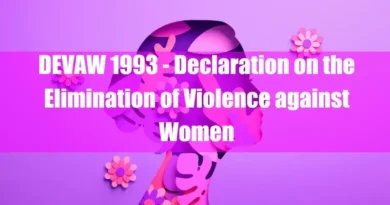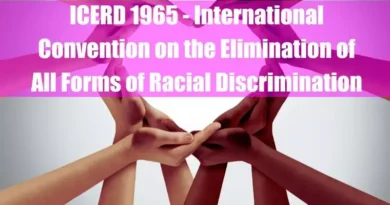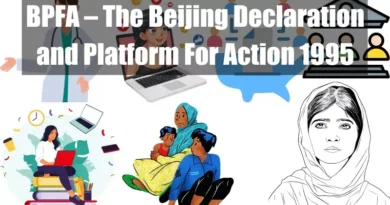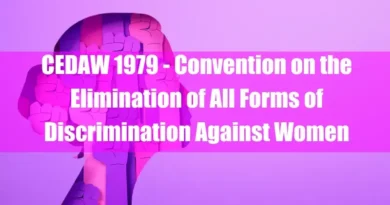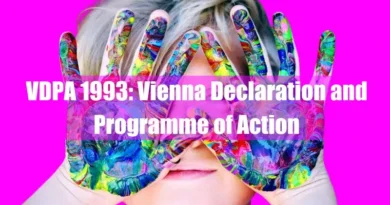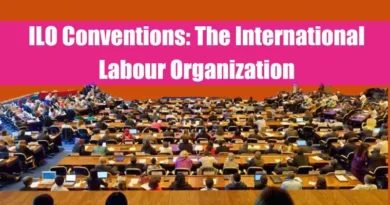CRC 1989 – Convention on the Rights of the Child
Takeaways
| Key Points |
|---|
| The core principles of the Convention on the Rights of the Child (CRC) emphasize non-discrimination, the best interests of the child, the right to life, survival, and development, and respect for the child’s views. |
| Non-discrimination (Article 2) ensures all children enjoy their rights regardless of background, while Article 3 prioritizes the child’s well-being in all decisions affecting them. |
| Article 6 guarantees every child’s right to life and development, emphasizing access to healthcare, nutrition, and education, while Article 12 promotes participatory decision-making by valuing children’s evolving opinions. |
| Protected rights include identity (Article 8), expression (Article 13), and privacy (Article 16), as well as family care, education, and leisure. |
| The CRC also establishes safeguards against abuse, neglect, exploitation, and supports refugee children (Article 22). Implementation and monitoring are achieved through state responsibilities, periodic reporting, and optional protocols. |
Introduction to the CRC 1989
Overview of the Convention
The Convention on the Rights of the Child (CRC) is a pivotal international legal document that defines children’s civil, political, economic, social, and cultural rights. Adopted by the United Nations General Assembly on November 20, 1989, it marks a significant milestone in the global movement to protect children’s rights.
The CRC is not merely a symbolic document but a legally binding treaty that obliges the nations that have ratified it to uphold its enshrined rights.
With 54 articles, the CRC covers a broad spectrum of issues, from the right to survival and development to education and protection from abuse and exploitation.
Historical Context and Adoption
The CRC emerged from a growing recognition that children require special care and protection, which was increasingly evident in the post-World War II era.
The United Nations Declaration of the Rights of the Child in 1959 laid the groundwork for what would eventually become the CRC. However, it was in the 1970s and 1980s that momentum truly built for a comprehensive treaty.
Spearheaded by the efforts of countries like Poland and supported by numerous non-governmental organizations, the drafting process of the CRC began in 1979.
It took a decade of negotiations before it was finalized in 1989.
Ratification and Global Significance
The CRC is the most widely ratified human rights treaty in history, with 196 countries having ratified it as of 2024. The United States remains the only UN member state that has yet to ratify the Convention. However, it has signed the document, signaling its intention to ratify it at a future date.
The widespread acceptance of the CRC underscores its universal relevance and the global consensus on protecting children’s rights. The treaty has significantly influenced national legislation, policies, and practices worldwide, helping to shape a better environment for children globally.
Core Principles of the CRC
Non-discrimination (Article 2)
One of the foundational principles of the CRC is non-discrimination. Article 2 of the Convention mandates that all rights must be respected and ensured for every child without discrimination of any kind, regardless of the child’s or their parent’s or legal guardian’s race, color, sex, language, religion, political or other opinion, national, ethnic or social origin, property, disability, birth, or other status.
This principle ensures that every child, regardless of their background or circumstances, is entitled to the full rights outlined in the CRC.
Best Interests of the Child (Article 3)
Article 3 of the CRC emphasizes that the child’s best interests must be a primary consideration in all actions concerning children, whether undertaken by public or private social welfare institutions, courts of law, administrative authorities, or legislative bodies.
This principle is a guiding factor in decisions that affect children, ensuring that their well-being is prioritized above all else. It mandates that states and institutions act to promote the child’s overall welfare, development, and protection.
Right to Life, Survival, and Development (Article 6)
Article 6 of the CRC affirms that every child has an inherent right to life. It obliges state parties to ensure the child’s survival and development to the maximum extent possible. This article protects the child’s right to life. It emphasizes the need for a nurturing environment where the child can grow and develop to their full potential.
This includes access to healthcare, adequate nutrition, and opportunities for education and personal growth.
Respect for the Views of the Child (Article 12)
Respect for the child’s views is a core element of the CRC, articulated in Article 12. It asserts that children capable of forming their own views have the right to express them freely in all matters affecting them, with their opinions being given due weight following their age and maturity. This principle recognizes the evolving capacities of children and the importance of including them in decisions that impact their lives.
It encourages a participatory approach where children’s voices are heard and considered.

Rights Protected under the CRC
Civil Rights and Freedoms
- Right to Identity (Article 8): The CRC emphasizes the child’s right to an identity, including nationality, name, and family ties. Article 8 ensures that these identity elements are protected and that no child is unlawfully deprived of any of them. This right is fundamental to a child’s sense of belonging and legal recognition.
- Freedom of Expression (Article 13): Article 13 guarantees every child the right to express their views, opinions, and information freely through any media they choose. This freedom is essential for the child’s personal development and active social participation.
- Freedom of Thought, Conscience, and Religion (Article 14): The CRC protects the child’s right to freedom of thought, conscience, and religion, allowing them to adopt a religion or belief of their choice and to practice it. States must respect parents’ or guardians’ rights and duties to guide exercising this right.
- Protection of Privacy (Article 16): Article 16 ensures that no child is subjected to arbitrary or unlawful interference with their privacy, family, home, or correspondence and that they are protected from attacks on their honor and reputation. This right is critical in safeguarding the child’s personal and family life from undue intrusion.
Family Environment and Alternative Care
- Parental Responsibilities and State Support (Article 5): The CRC recognizes the role of parents and families in the upbringing and development of children. Article 5 asserts that states must respect the responsibilities, rights, and duties of parents or guardians to provide appropriate direction and guidance in a manner consistent with the evolving capacities of the child.
- Family Reunification (Article 10): The CRC upholds the right of children and their parents to enter or leave a country for family reunification. States are required to deal with such requests in a positive, humane, and expeditious manner.
- Protection from Abuse and Neglect (Article 19): Article 19 mandates that states protect children from all forms of physical or mental violence, injury or abuse, neglect or negligent treatment, maltreatment, or exploitation, including sexual abuse. It also requires the establishment of social programs to provide support to children and caregivers and the development of mechanisms for reporting abuse.
Basic Health and Welfare
- Right to Health and Healthcare Services (Article 24): The CRC recognizes the child’s right to the enjoyment of the highest attainable standard of health and to facilities for the treatment of illness and rehabilitation of health. Article 24 obliges states to diminish infant and child mortality, ensure the provision of necessary medical assistance and healthcare, and combat disease and malnutrition.
- Right to an Adequate Standard of Living (Article 27): Article 27 ensures the right of every child to a standard of living adequate for their physical, mental, spiritual, moral, and social development. It places the primary responsibility for this on parents, requiring states to assist parents and guardians in fulfilling this responsibility.
Education, Leisure, and Cultural Activities

- Right to Education (Article 28): The CRC guarantees the child’s right to education and requires states to make primary education compulsory and free. Secondary education should be available and accessible to every child, and higher education should be made accessible based on capacity.
- Aims of Education (Article 29): Article 29 outlines the goals of education, including the development of the child’s personality, talents, and mental and physical abilities to their fullest potential. Education should also prepare the child for a responsible life in a free society, fostering respect for human rights and fundamental freedoms.
- Right to Play and Leisure (Article 31): The CRC acknowledges the right of the child to rest and leisure, to engage in play and recreational activities appropriate to their age, and to participate freely in cultural life and the arts. This right is essential for the child’s well-being and overall development.
Special Protection Measures
- Protection of Refugee Children (Article 22): The CRC provides special protection for children seeking refugee status or considered refugees. States must ensure that such children receive appropriate protection and humanitarian assistance, whether accompanied by their parents or not.
- Rights of Children in Conflict with the Law (Article 37): Article 37 of the CRC sets standards for treating children accused of, charged with, or convicted of a criminal offense. It prohibits torture, cruel or inhuman treatment, capital punishment, and life imprisonment without the possibility of release for offenses committed by persons under 18.
- Protection from Economic Exploitation (Article 32): The CRC safeguards children from economic exploitation and from performing any work that is likely to be hazardous, interfere with their education, or harm their health or development. This article obliges states to implement measures to prevent the exploitation of children in the labor market.
Implementation and Monitoring
Role of State Parties in Implementation (Article 4)
Article 4 of the CRC places state parties responsible for taking all necessary legislative, administrative, and other measures to implement the rights recognized in the Convention. This article acknowledges the varying resources available to different countries, urging wealthier nations to assist those with fewer resources to ensure that every child’s rights are fully realized.
The emphasis is on the progressive realization of economic, social, and cultural rights, considering each state’s specific circumstances and capacities.
Reporting and Monitoring Mechanisms (Article 44)
Article 44 requires state parties to submit regular reports to the Committee on the Rights of the Child on the measures they have taken to implement the Convention and the progress made. These reports must be submitted two years after ratification and every five years after that. The Committee reviews these reports, engages in dialogue with the states, and recommends further improvements.
This reporting mechanism is essential for holding states accountable and ensuring that the CRC’s provisions are effectively implemented.

The Role of the Committee on the Rights of the Child
The Committee on the Rights of the Child is a body of independent experts established to monitor the implementation of the CRC by state parties. The Committee examines the reports submitted by states and can request additional information or clarification.
It also issues general comments and organizes thematic discussions to provide guidance on specific articles or issues related to children’s rights. The Committee’s work is crucial in ensuring that the CRC remains a living document, responsive to emerging challenges and continuously advancing the protection of children’s rights.
Optional Protocols to the CRC
Optional Protocol on the Involvement of Children in Armed Conflict
Adopted in 2000, the Optional Protocol on the Involvement of Children in Armed Conflict aims to protect children from recruitment and use in hostilities. It raises the minimum age for direct participation in armed conflict to 18 years. It obliges state parties to take all feasible measures to prevent such recruitment.
This protocol reflects a global commitment to safeguarding children from the horrors of war and ensuring their right to a peaceful childhood.
Optional Protocol on the Sale of Children, Child Prostitution, and Child Pornography
The Optional Protocol on the Sale of Children, Child Prostitution, and Child Pornography, also adopted in 2000, addresses the specific forms of exploitation that children may face.
It requires state parties to criminalize these acts and to adopt national and international measures to prevent them, protect victims, and prosecute offenders. This protocol strengthens the CRC’s provisions on the protection of children from sexual exploitation and abuse, reflecting the international community’s determination to combat these severe violations of children’s rights.
Optional Protocol on a Communications Procedure
The Optional Protocol on a Communications Procedure, adopted in 2011, allows children or their representatives to submit complaints to the Committee on the Rights of the Child if their rights have been violated and if domestic remedies have been exhausted. This protocol empowers children to seek justice at the international level and enhances the accountability of states for upholding the CRC’s provisions.
It represents an important step in ensuring that children’s voices are heard and their rights are effectively protected.

Impact and Criticisms
Global Impact of the CRC
The CRC has profoundly impacted the global landscape of children’s rights. It has influenced national laws, policies, and practices, significantly improving child protection, education, and healthcare.
The Convention has also inspired the creation of numerous organizations and initiatives dedicated to promoting and protecting children’s rights. Its universal ratification underscores the global consensus on safeguarding children’s rights and recognizing them as rightsholders.
Criticisms and Challenges in Implementation
Despite its successes, the CRC has faced criticism and challenges in implementation. Critics argue that the Convention’s provisions are not always effectively enforced, particularly in countries with limited resources or ongoing conflicts. There are also concerns about the gap between the rights enshrined in the CRC and the realities faced by many children, particularly those in marginalized or vulnerable situations.
Furthermore, some have questioned the ability of the Committee on the Rights of the Child to effectively monitor compliance, given the sheer number of state parties and the varying levels of commitment to the Convention.
The Role of Civil Society and NGOs
Civil society organizations and non-governmental organizations (NGOs) have played a crucial role in advancing the implementation of the CRC. These organizations often act as watchdogs, holding governments accountable for their obligations under the Convention.
They also provide essential services to children, advocate for policy changes, and raise public awareness about children’s rights. NGOs have been instrumental in bridging the gap between the CRC’s principles and their practical application, particularly in regions lacking government resources or political will.
FAQ
What is the Convention on the Rights of the Child (CRC) 1989?
The Convention on the Rights of the Child, adopted by the United Nations in 1989, is a comprehensive human rights treaty that establishes children’s civil, political, economic, social, and cultural rights. It defines a child as any human being under the age of 18 unless the majority is attained earlier under a nation’s laws. The CRC emphasizes that children are not merely passive recipients of care but are individuals with their own rights, deserving of respect and protection.
Which countries have ratified the CRC?
As of October 2015, the CRC has been ratified by 196 countries, making it the most universally accepted human rights treaty in history. Notably, the United States remains the only United Nations member state that has not ratified the Convention. This widespread ratification underscores a global commitment to recognizing and upholding the rights of children.
What are the guiding principles of the CRC?
The CRC is founded on four core principles: non-discrimination; the best interests of the child as a primary consideration; the inherent right to life, survival, and development; and respect for the views of the child. These principles serve as the framework for interpreting and implementing all other rights outlined in the Convention, ensuring a holistic approach to child welfare.
How does the CRC define a child?
According to the CRC, a child is any person below the age of 18 unless national laws stipulate an earlier age of majority. This definition ensures that all individuals under 18 are entitled to the rights and protections enshrined in the Convention, promoting a universal standard for child rights across diverse legal systems.
What rights does the CRC grant to children?
The CRC grants children a comprehensive array of rights, including the right to life, health, education, and play. It also ensures protection from abuse, neglect, and exploitation and upholds the child’s right to participate in decisions affecting their lives. These provisions aim to foster an environment where children can develop to their fullest potential.
How does the CRC protect children’s rights?
The CRC obliges States Parties to align their national laws and policies with its standards, ensuring that all children benefit from special protection measures and assistance. Governments are required to submit regular reports to the Committee on the Rights of the Child, detailing their progress in implementing the Convention’s provisions. This reporting mechanism promotes accountability and continuous improvement in safeguarding children’s rights.
What is the Committee on the Rights of the Child?
The Committee on the Rights of the Child is a body of 18 independent experts responsible for monitoring the implementation of the CRC by its States Parties. The Committee reviews periodic reports submitted by governments and provides recommendations to guide them in fulfilling their obligations under the Convention. This process ensures that children’s rights are consistently upheld across different jurisdictions.
How does the CRC address cultural differences?
The CRC was developed over a decade through negotiations involving governments, non-governmental organizations, and various experts worldwide. It reflects a global consensus that acknowledges the importance of tradition and cultural values in the protection and harmonious development of the child. This inclusive approach ensures that the Convention’s principles are adaptable to diverse cultural contexts while maintaining universal standards for children’s rights.
What are the Optional Protocols to the CRC?
The CRC includes three Optional Protocols that address specific issues: the involvement of children in armed conflict; the sale of children, child prostitution, and child pornography; and a communications procedure that allows children to submit complaints about violations of their rights. These protocols strengthen the Convention by providing additional protections and mechanisms to address emerging challenges affecting children.
How does the CRC influence national laws?
By ratifying the CRC, countries commit to harmonizing their national legislation with the Convention’s provisions. This commitment often leads to significant legal and policy reforms to enhance child protection, welfare, and rights. The CRC is a benchmark for evaluating and improving national laws to ensure they align with international standards for children’s rights.
What is UNICEF’s role concerning the CRC?
UNICEF, the United Nations Children’s Fund, is explicitly mentioned in the CRC as a source of expert assistance and advice. The organization plays a pivotal role in advocating for the implementation of the Convention, supporting governments in fulfilling their obligations and providing programs and services that promote the well-being and rights of children worldwide.
How does the CRC define the best interests of the child?
The CRC mandates that the child’s best interests be a primary consideration in all actions concerning children. This principle ensures that decision-makers prioritize the child’s well-being and holistic development when formulating policies or making decisions that affect them. It is a guiding standard to protect children from harm and promote their overall welfare.
How does the CRC address child participation?
The CRC recognizes the right of children to express their views freely in all matters affecting them, with due weight given to their opinions in accordance with their age and maturity. This acknowledgment empowers children to participate actively in decision-making processes, fostering a sense of agency and respect for their perspectives.
What is the significance of the CRC being widely ratified?
The near-universal ratification of the CRC signifies a global consensus on the importance of upholding children’s rights. This widespread acceptance provides a common ethical and legal framework that guides nations in formulating policies and laws to protect and promote children’s well-being. It also facilitates international cooperation in addressing cross-border issues affecting children.
How does the CRC address discrimination against children?
The CRC emphasizes the principle of non-discrimination, ensuring that all children, regardless of race, religion, gender, disability, or any other status, have equal access to the rights it outlines. This principle mandates that no child should suffer from any form of discrimination, promoting inclusivity and equality in all aspects of a child’s life.
How does the CRC impact children’s education rights?
The CRC guarantees every child’s right to education. It obliges States Parties to make primary education compulsory and free for all children. Additionally, it encourages the development of various forms of secondary education, including general and vocational education, making them available and accessible to every child. This commitment ensures that education serves as a tool for personal development and empowerment.
How does the CRC address child labor?
The CRC requires States Parties to protect children from economic exploitation and from performing any work that is likely to be hazardous, interfere with their education, or be harmful to their health or development. This includes setting minimum employment age and regulating working conditions to safeguard children’s well-being.
How does the CRC protect children in armed conflict?
The CRC, along with its Optional Protocol on the involvement of children in armed conflict, prohibits the recruitment and use of children under the age of 18 in hostilities. It mandates that States Parties take all feasible measures to ensure that children do not take a direct part in conflicts and are protected from the horrors of war.
How does the CRC address child abuse and neglect?
The CRC obliges States Parties to take all appropriate legislative, administrative, social, and educational measures to protect children from all forms of physical or mental violence, injury, abuse, neglect, maltreatment, or exploitation. This comprehensive approach ensures a protective environment for children, promoting their safety and well-being.
How can individuals support the implementation of the CRC?
Individuals can support the CRC by advocating for children’s rights, raising awareness about the Convention, supporting organizations that work towards its implementation, and engaging in community initiatives that promote child welfare. Additionally, staying informed about children’s issues and participating in policy discussions can contribute to effectively realizing the rights enshrined in the CRC.




